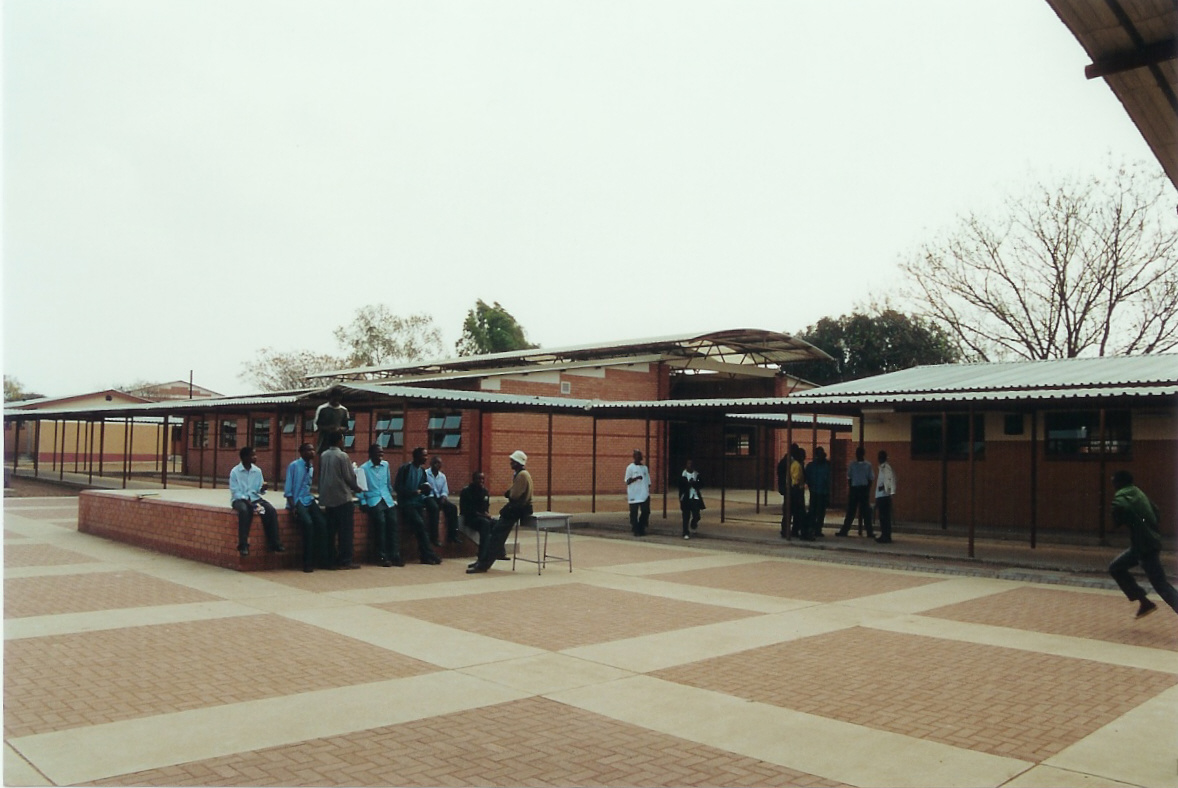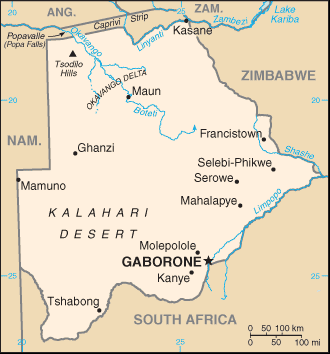|
Molepolole
Molepolole is a large village in Kweneng District, Botswana. The people who reside in Molepolole are called Bakwena, who are one of the eight major tribes in Botswana. The Bakwena Kgosi (Chief), Sebele I was among the three chiefs who went to England to seek protection from the British in the colonial era. Molepolole serves as the capital of the Bakwena. It was named after the Molepolole river. It is one of the largest traditional villages in Africa with a population of over 73,102 people as of 2011. It lies 50 kilometres west of the national capital Gaborone and acts as gateway for exploring the Kalahari Desert. It has a large traditional kgotla and the Scottish Livingstone Hospital, is found in Molepolole. History Ntsweng was the capital of Bakwena before they moved to Molepolole. Ntsweng is a historic site located a few kilometers southeast of Molepolole. The area was first occupied by Bakwena, led by Sechele I (ruled 1829–92), in 1864. It was abandoned in 1937 when Ba ... [...More Info...] [...Related Items...] OR: [Wikipedia] [Google] [Baidu] |
Scottish Livingstone Hospital
Scottish Livingstone Hospital, also known as Molepolole Hospital, is a government-run district hospital located in Molepolole, Botswana, from Gaborone. History The hospital was built in 1933 by the United Free Church of Scotland. It opened the following year on 3 September, and Dr Sheppard was the first doctor. At the time, the hospital only held 20 beds. Facilities In order to combat the ongoing HIV/AIDS epidemic, the government opened a new hospital building in November 2007. The new building, built by Arup, hosts 350 beds and features high-tech heating and cooling systems. The hospital houses an Infections Disease Care Clinic that offers antiretroviral therapy. Most of the doctors speak only English while the patients speak mostly Setswana. Thus, medical care is usually given through a translator. The number of doctors and amount of medical equipment is limited: There is only one x-ray machine and no radiologist. There are long wait times to see a doctor, and the obstetr ... [...More Info...] [...Related Items...] OR: [Wikipedia] [Google] [Baidu] |
Molepolole Stadium
Molepolole Sports Complex is a stadium in Molepolole, Botswana Botswana (, ), officially the Republic of Botswana ( tn, Lefatshe la Botswana, label=Setswana, ), is a landlocked country in Southern Africa. Botswana is topographically flat, with approximately 70 percent of its territory being the Kalahar .... The multi sports complex consists of a track and field stadium known for its hosting of some football games from the national league. The pitch surface is artificial and it had to be relaid in 2008 at FIFA's request. In 2010, it was chosen as one of two host stadiums for the COSAFA Under-20 Challenge. References Football venues in Botswana Multi-purpose stadiums in Botswana {{Botswana-sports-venue-stub ... [...More Info...] [...Related Items...] OR: [Wikipedia] [Google] [Baidu] |
Kweneng District
Kweneng is one of the districts of Botswana and is the recent historical homeland of the Bakwena people, the first group in Botswana converted to Christianity by famed missionary David Livingstone. Various landmarks, including Livingstone's Cave, allude to this history. The seat of the district's government is Molepolole, Botswana's most populous village (only trailing Botswana's two cities: Gaborone and Francistown). It borders Central District in northeast, Kgatleng District on the east, South-East District in southeast, Southern District in south, Kgalagadi District in the west, Ghanzi District in the north. The district is administered by a district administration and district council which are responsible for local administration. Manyana rock paintings in Manyana village and Kgosi Sechele I Museum are the major attractions in the district. As of 2011, the total population of the district was 304,549 compared to 230,335 in 2001. The growth rate of population during the de ... [...More Info...] [...Related Items...] OR: [Wikipedia] [Google] [Baidu] |
Sechele I
Sechele I a Motswasele "Rra Mokonopi" (1812–1892), also known as Setshele, was the ruler of the Kwêna people of Botswana. He was converted to Christianity by David Livingstone and in his role as ruler served as a missionary among his own and other African peoples. According to Livingstone biographer Stephen Tomkins, Sechele was Livingstone's only African convert to Christianity, even though Livingstone himself came to regard Sechele as a "backslider". Sechele led a coalition of Batswana (Bakwêna, Bakaa, Balete, Batlokwa) in the Battle of Dimawe in 1852. Early life Sechele was born in 1812, the son of the chief of the Kwêna tribe of Tswana people of what is modern-day Botswana. When Sechele was ten years old, his father was killed and the leadership of the tribe was divided between his two uncles. Sechele and some of his supporters fled into the desert. He spent some years among the Ngwato people and married Mokgokong, a daughter of Chief Kgari. In about 1831 he succ ... [...More Info...] [...Related Items...] OR: [Wikipedia] [Google] [Baidu] |
Botswana
Botswana (, ), officially the Republic of Botswana ( tn, Lefatshe la Botswana, label=Setswana, ), is a landlocked country in Southern Africa. Botswana is topographically flat, with approximately 70 percent of its territory being the Kalahari Desert. It is bordered by South Africa to the south and southeast, Namibia to the west and north, and Zimbabwe to the northeast. It is connected to Zambia across the short Zambezi River border by the Kazungula Bridge. A country of slightly over 2.3 million people, Botswana is one of the most sparsely populated countries in the world. About 11.6 percent of the population lives in the capital and largest city, Gaborone. Formerly one of the world's poorest countries—with a GDP per capita of about US$70 per year in the late 1960s—it has since transformed itself into an upper-middle-income country, with one of the world's fastest-growing economies. Modern-day humans first inhabited the country over 200,000 years ago. The Tswana ethnic ... [...More Info...] [...Related Items...] OR: [Wikipedia] [Google] [Baidu] |
Gaborone
Gaborone ( , , ) is the capital and largest city of Botswana with a population of 246,325 based on the 2022 census, about 10% of the total population of Botswana. Its agglomeration is home to 421,907 inhabitants at the 2011 census. Gaborone is situated between Kgale Hill and Oodi Hill, near the confluence of the Notwane River and Segoditshane River in the south-eastern corner of Botswana, from the South African border. The city is served by the Sir Seretse Khama International Airport. It is an administrative district in its own right, but is the capital of the surrounding South-East District. Locals often refer to the city as ''GC or Motse-Mshate''. The city of Gaborone is named after Chief Gaborone of the Tlokwa tribe, who once controlled land nearby. Because it had no tribal affiliation and was close to fresh water, the city was planned to be the capital in the mid-1960s when the Bechuanaland Protectorate became an independent nation. The centre of the city is a lon ... [...More Info...] [...Related Items...] OR: [Wikipedia] [Google] [Baidu] |
Botswana Prison Service
The Botswana Prison Service (BPS) is the corrections agency of Botswana. It holds pre-trial and convicted prisoners.Prisons and Rehabilitation " Archive . Retrieved on 26 March 2013. Prisons * ( Kanye) *[...More Info...] [...Related Items...] OR: [Wikipedia] [Google] [Baidu] |
Sub-districts Of Botswana
] The districts of Botswana are subdivided into sub-districts. The sub-districts are listed below, by district: * Bobirwa, headquarters at Bobonong * Boteti, headquarters at Letlhakane * Lerala * Mahalapye * Mmadinare * Mmaphashalala * Mogorosi * Nata * Paje * Rakops * Sebina * Sefhare * Serowe/Palapye * Shoshong * Taupye * Tonota, split from Tutume * Tutume * Lecheng [orapa Chobe District">rapa.html" ;"title="[orapa">[orapa Chobe District * Kasane Ghanzi District * Charles Hill, Botswana, Charleshill * Ghanzi headquarters at New Xhade Kgalagadi District * Hukuntsi * Kang, Botswana, Kang * Tshabong *Khawa *Werda *Makopong *Omaweneno *Tsabong *Kolonkwane *Middlepits *Khuis *Gachibana *Bokspits *Struizendam *Phepheng/Draaihoek *Maubelo *Kokotsha *Maralaleng *Maleshe * Mmathubudukwane *Mochudi *Bokaa *Oodi *Modipane *Mabalane *Sikwane *Malolwane *Ramonaka *Oliphants Drift/ Dikgonnye *Artesia *Malotwana *Leshibitse *Ramathabaki *Kgomodiatshaba Kweneng ... [...More Info...] [...Related Items...] OR: [Wikipedia] [Google] [Baidu] |
List Of Cities In Botswana ...
The following is a list of cities and towns in Botswana with population of over 3,000 citizens. State capitals are shown in boldface. References {{DEFAULTSORT:List Of Cities In Botswana Botswana, List of cities in Botswana Cities A city is a human settlement of notable size.Goodall, B. (1987) ''The Penguin Dictionary of Human Geography''. London: Penguin.Kuper, A. and Kuper, J., eds (1996) ''The Social Science Encyclopedia''. 2nd edition. London: Routledge. It can be def ... [...More Info...] [...Related Items...] OR: [Wikipedia] [Google] [Baidu] |
Kolobeng Mission
Kolobeng Mission (also known as the Livingstone Memorial), built in 1847, the third and final mission of David Livingstone, a missionary and explorer of Africa. Located in the country of Botswana, west of Kumakwane and west of Gaborone off the Thamaga-Kanye Road, the mission housed a church and a school and was also the home of David Livingstone, his wife Mary Livingstone, and their children. While here, Livingstone converted Sechele I, kgosi of the Bakwena and taught them irrigation methods using the nearby Kolobeng River. A drought began in 1848, and the Bakwena blamed the natural disaster on Livingstone's presence. In 1852, Boer farmers attacked the tribes in the area, including the Bakwena at Kolobeng in the Battle of Dimawe. This prompted the Livingstones to leave Kolobeng, and the mission was abandoned. A fence was installed around the site in 1935, and the mission is now preserved by the Department of National Museum and Monuments under Botswana's Ministry of Environme ... [...More Info...] [...Related Items...] OR: [Wikipedia] [Google] [Baidu] |
Sebele I
Sebele I was a chief (''kgosi'') of the Kwena —a major Tswana tribe (''morafe'') in modern-day Botswana— who ruled from 1892 until his death in 1911. During his lifetime, he resisted the 1885 Bechuanaland Protectorate"Sechele’s tribe proved by no means unanimous in welcoming the Protectorate. Sebele, the eldest son of the chief, protested against their country being taken from them without their consent." (T.E. Malebeswa (2020): ''Tribal Territories Act, indirect rule, chiefs and subjects'') as well as the control of his domains by Cecil Rhodes' British South African Company, which was administering, by a royal charter signed in October 1889, his homeland in the Bechuanaland Protectorate and other regions of Central Africa. With support from Christian missionaries, Sebele traveled to Britain in 1895 along with Bathoen I and Khama III to argue against the latest attempts to incorporate the protectorate into the Cape Colony. They managed to secure support from Que ... [...More Info...] [...Related Items...] OR: [Wikipedia] [Google] [Baidu] |
David Livingstone
David Livingstone (; 19 March 1813 – 1 May 1873) was a Scottish physician, Congregationalist, and pioneer Christian missionary with the London Missionary Society, an explorer in Africa, and one of the most popular British heroes of the late 19th-century Victorian era. David was the husband of Mary Moffat Livingstone, from the prominent 18th Century missionary family, Moffat. He had a mythic status that operated on a number of interconnected levels: Protestant missionary martyr, working-class "rags-to-riches" inspirational story, scientific investigator and explorer, imperial reformer, anti-slavery crusader, and advocate of British commercial and colonial expansion. Livingstone's fame as an explorer and his obsession with learning the sources of the Nile River was founded on the belief that if he could solve that age-old mystery, his fame would give him the influence to end the East African Arab–Swahili slave trade. "The Nile sources", he told a friend, "are valuabl ... [...More Info...] [...Related Items...] OR: [Wikipedia] [Google] [Baidu] |




